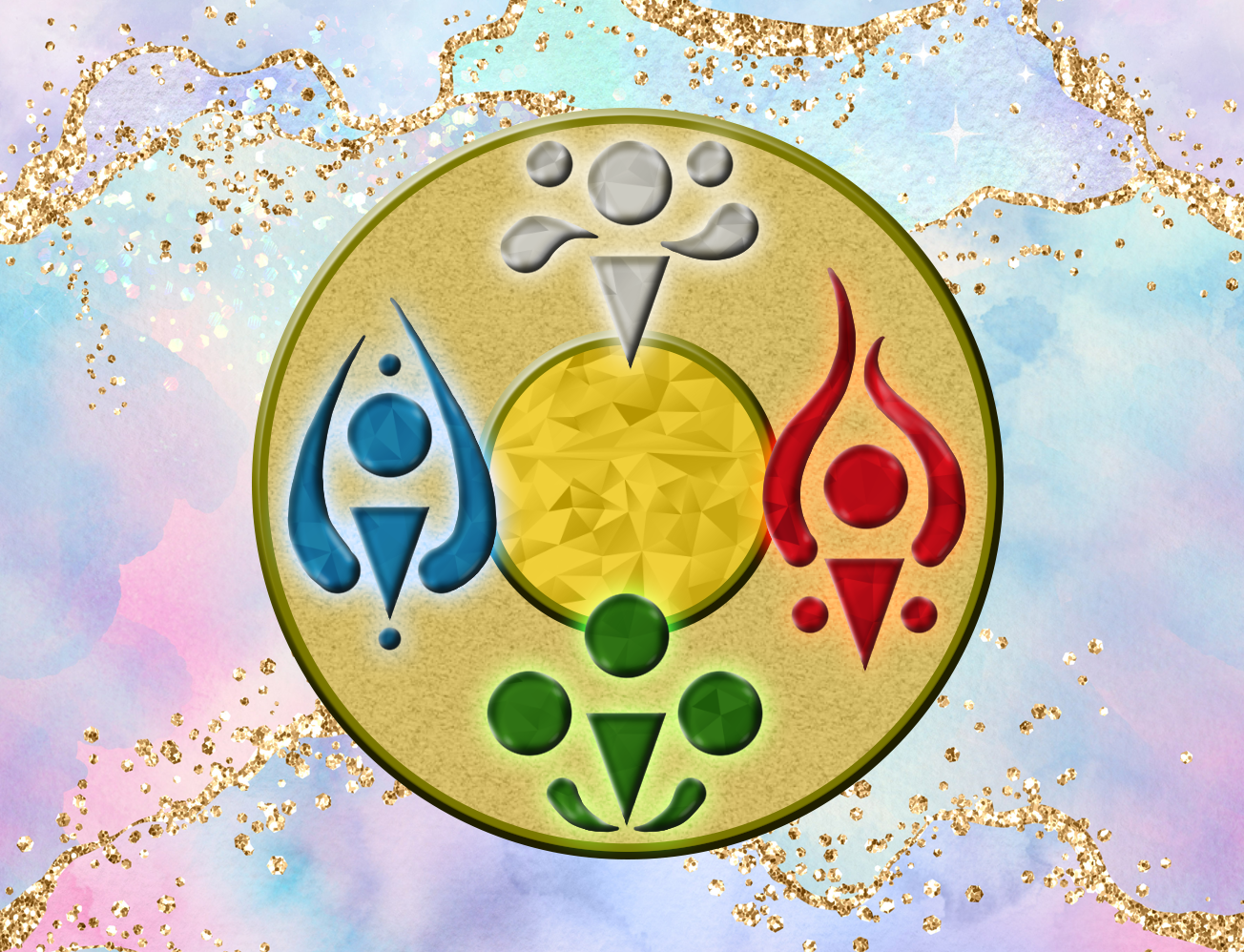Elemental Deities
March 3, 1762 AG
Concerning the Gods
Magic
Hm. Is that the best place to start?
It has to be. What else would you start with when talking about gods? They are magic.
So then. Magic.
We’ll start with the basic elements, I suppose. Or the basic elements as I have come to know them, though the hierarchy of the gods supports this view (however, I am mildly disturbed with how the Lady just laughs at me whenever I try to discuss it with Her, so perhaps we are all completely off base).
Anyway.
Mark of the Espera
The Espera
The twins Esper and Espa, gods of air, lightning, winds, and storms.
Responsible for the creation of the Gini, though few of them worship their creators, preferring Selenae’s perpetual search for knowledge over the Espera’s capricious whimsy. However, there is something to be said for the link between the Espera and inspiration and imagination.
Temples tend to be in high places. Offerings tend towards methods of scenting the air (burning herbs, perfumes, incense, strongly scented flowers, etc.), feathers with unique or aesthetic qualities, music, and wine. People who are planning on traveling will often make offerings, hoping for ideal weather and safe traveling conditions. I’ve also known particularly desperate students to beg for their aid.
The continent of Espon is named for them, with the Gini living in the northern mountains.
Why are there only two Espera, if there are supposedly four winds?
Mark of the Faleri
The Faleri
The twins Falere and Falera, gods of fire, passion, and mystery.
Responsible for the creation of the Aradians, to whom they gave the gift of fire magic. I have never known an Aradian who did not worship the Faleri with great reverence, though many hold Lanarae and her battle prowess in high regard as well.
The Aradians have built great temples among the sands of the Dalmaran desert in their names, and their priests are greatly respected throughout their culture. Offerings can include the simple act of lighting a candle or cooking a meal, smoke, riddles, ash, or sun-catchers. People who are hoping for change might leave offerings, and those who find themselves in positions of authority pray to them for insight and strength.
The eastern continent of Falin is named for them, home to the Aradians.
I’ve heard rumors that sex is another way the Aradians worship, but cannot confirm this. Certainly it would align with the physicality of Aradian culture.
Mark of the Nyphoren
The Nyphoren
The twins Nyphore and Nyphora, gods of water, the ocean, tides, and storms.
Responsible for the creation of the Veren, who worship them in conjunction with the Distant Trinity for their astrological associations.
There are few holy sites remaining due to the Empire’s takeover of the islands. Offerings are often seashells or seaweed, fish, pure water, clear alcohols, or cucumbers. Those who scry often pray to the Nyphoren first, and their aid is the first sought in the case of drought or severe flooding. Those who seek things that are lost will ask for their help as well.
The Nyphoren Islands in the west are names for them, and even now the Veren live in the reefs and deep caves below them.
There are some who say there are underwater grottos that are the true holy sites, and those above are merely decoys. This would fit thematically with the Veren talent for illusion, but if it is true, why did they fight so fiercely for the land above?
Mark of the Patoran
The Patoran
The twin gods Patori and Patera, gods of the earth, plants, wisdom, and vitality.
Responsible for the creation of the Lowkeef, who hold the Patoran and Firilae in equal regard, perhaps recognizing the importance of life and magic being the same.
I know of no one who has seen how the Lowkeef worship, but small shrines to the Patoran are popular decorations for gardens in the north. Flowers, precious stones, fruit or vegetables, salt, and a mixture of milk and honey are common offerings. Those hoping for wealth, stability, and fertility most often leave them offerings, and it would be foolish for anyone attempting to grow a garden not to seek their favor.
The southern continent of Patoran is named for them, and the Lowkeef hide in The Forbidden south of Carthago-Mir and the mountains.
I must admit I know the least about the Lowkeef, and my singular encounter with one did not leave me interested in finding out more.
General Thoughts
Though I’ve given a very… fragmented overview of these eight deities, it must be noted that they are worshiped to some degree in all cultures around the globe. Even here in Tarvishte I can think of multiple shrines to all four twin sets within walking distance, should I choose to go to them (I do not). Small sects with varying religious structures and organizations exist as well.
Nyphora giving the Crystal Light of Water to Ebryn, from a children’s storybook
The Crystal Lights
Seven hundred and fifty some-odd years ago, the elemental deities surrendered powerful artifacts — the crystal lights — to Ebryn Stormlight. The crystal lights were repositories of their power, guarded by their respective races, and the Lady Hades forged them into what is now known as the Crystal Light Blade. Its purpose is to destroy Abomination, and it was bound to Ebryn directly — of all people then and now, only he would ever be able to wield it to its full potential.
This knowledge would have been appreciated that last night in Elbe, but then, I doubt it would have changed the final outcome anyway.
-Ander 3/3/62





